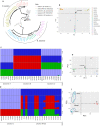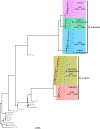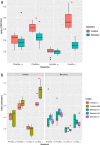The integrative taxonomy of Beauveria asiatica and B. bassiana species complexes with whole-genome sequencing, morphometric and chemical analyses
- PMID: 37693793
- PMCID: PMC10486633
- DOI: 10.3767/persoonia.2021.47.04
The integrative taxonomy of Beauveria asiatica and B. bassiana species complexes with whole-genome sequencing, morphometric and chemical analyses
Abstract
Fungi are rich in complexes of cryptic species that need a combination of different approaches to be delimited, including genomic information. Beauveria (Cordycipitaceae, Hypocreales) is a well-known genus of entomopathogenic fungi, used as a biocontrol agent. In this study we present a polyphasic taxonomy regarding two widely distributed complexes of Beauveria: B. asiatica and B. bassiana s.lat. Some of the genetic groups as previously detected within both taxa were either confirmed or fused using population genomics. High levels of divergence were found between two clades in B. asiatica and among three clades in B. bassiana, supporting their subdivision as distinct species. Morphological examination focusing on the width and the length of phialides and conidia showed no difference among the clades within B. bassiana while conidial length was significantly different among clades within B. asiatica. The secondary metabolite profiles obtained by liquid chromatography-mass spectrometry (LC-MS) allowed a distinction between B. asiatica and B. bassiana, but not between the clades therein. Based on these genomic, morphological, chemical data, we proposed a clade of B. asiatica as a new species, named B. thailandica, and two clades of B. bassiana to respectively represent B. namnaoensis and B. neobassiana spp. nov. Such closely related but divergent species with different host ranges have potential to elucidate the evolution of host specificity, with potential biocontrol application. Citation: Kobmoo N, Arnamnart N, Pootakham W, et al. 2021. The integrative taxonomy of Beauveria asiatica and B. bassiana species complexes with whole-genome sequencing, morphometric and chemical analyses. Persoonia 47: 136-150. https://doi.org/10.3767/persoonia.2021.47.04.
Keywords: Beauveria; chemotaxonomy; population genomics; taxonomy.
© 2021 Naturalis Biodiversity Center & Westerdijk Fungal Biodiversity Institute.
Figures








References
-
- Abdessamad I. 2019. Transitions from single- to multi-locus approach in determining cryptic and describing new species within Beauveria genus (Cordycipitaceae, hypocreales): A review. Phytotaxa 413: 257–273.
-
- Aquino De Muro M, Elliott S, Moore D, et al. 2005. Molecular characterisation of Beauveria bassiana isolates obtained from overwintering sites of Sunn Pests (Eurygaster and Aelia species). Mycological Research 109: 294–306. - PubMed
LinkOut - more resources
Full Text Sources
Research Materials
Miscellaneous
